300 years after * an exhibition in Britain in memory of the physicist Robert Hooke will try to correct the injustices of the historical confrontation between him and Newton; Evidence from the 17th and 18th centuries: Newton's supporters destroyed Hooke's scientific theories
By: Lior Kodner, Haaretz, Walla!

Isaac Newton (1642-1727) and Robert Hooke (1635-1703) are considered the greatest British physicists from the mid-17th century to the mid-18th century. However, while Newton's picture can be found in almost every encyclopedia or science book, pictures documenting Hooke are almost non-existent. According to various testimonies from that time, Newton's supporters made sure to destroy any trace of his great rival and the scientific theories presented by Hooke were not recognized.
Today, 300 years after his death, an exhibition in memory of Robert Hooke opens in London. The members of the British Royal Society of Sciences wish to present in the exhibition the scientific theories developed by Hooke, as well as pictures of the scientist drawn in modern times. "In the exhibition, we want to bring Hook out of the limelight," says the initiator of the exhibition, Prof. Michael Cooper. "Hook always remained in the image of other people, especially his great enemy Newton and his great friend the scientist Christopher Warren. While Newton made sure to deny all of Hooke's scientific inventions and did everything in his power to erase him from the pages of history, Warren gained scientific recognition mainly based on Hooke's work."
Hooke's scientific work contributed greatly to the development of physics, astronomy and biology, and at the same time led to the development of the modern clock; Research on springs led Hooke to assembling clocks. He was one of the first scientists to examine plant matter under a microscope - in 1667 Hooke discovered the existence of cells in cork - but his most important contribution to physics was recorded seven years earlier, when he was only 25 years old, when he discovered the law that bears his name. The law states that the stress exerted on an elastic object is directly proportional to its stretch. Hooke formulated the principles of the law in a short sentence in Latin: ut tensis, sic vis.
In addition to this, Hooke also studied the stars of the solar system. He contributed to the development of the modern telescope and developed a new theory regarding the formation of craters on the surface of the moon. Following the observations he made, he developed an independent approach to the force of gravity, which eventually led to a bitter confrontation between him and the developer of the overall theory of the force of gravity, Newton.
Hawke was relegated to the margins of history
In 1662, Hooke began to study the outer shape of the stars of the solar system, and in this way sought to understand the mechanical mechanism by which the force of gravity works. 12 years later Hooke found that the force of gravity causes different bodies to move in circles and that the closer the bodies are to the source of the force, the greater its effect. In 1680, Hooke formulated his findings in a physical law. When Newton published his law of gravitation, Hooke claimed that the work was based largely on his findings on the subject of the stars.
Newton refused to acknowledge Hooke's scientific contribution, and never forgave his words. The great scientist, whose human relations were notorious, sought to damage Hooke's status by defaming his name and invalidating his scientific theories. As someone who gained great standing in the scientific community following the development of the law of gravity and then the laws of motion, he managed to push Hooke to the margins of history. After Hooke's death, his scientific contribution was forgotten; His portrait was also apparently destroyed by Newton's men.

3 תגובות
Actually the physics teacher told us about Hooke.. D: And we saw a movie about him and Newton
What a piece of shit!
You almost didn't tell about Hook Robert!!
He was a scientist! bullshit..!!